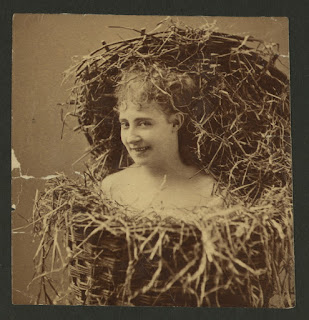The first in the "Girls Behaving Badly" blog series by Sheila Moeschen
Burlesque. It’s a term that conjures up images of blue-lit cabaret stages where women adorned in sequins and pasties, pranced, danced, teased, and tantalized boozy execs (think Mad Men’s Roger Sterling, wearing that maddening, boyish smirk as he swirls his scotch and gazes on the shimmying hips and legs before him.) Burlesque is sexual revolution! It’s counter-culture! It’s comedy! What now?
Before Burlesque became parlance for strip-tease light, it was a distinctive comic form, largely driven by women. Burlesque arrived in America in the 1860s via a sassy English lassie named Lydia Thompson along with her troupe of fair-haired female performers known as the British Blondes. The girls performed wearing *gasp * short skirts, similar to those worn by ballerinas.
Lydia Thompson
But the British Blondes were no statuesque, elegantly limbed ballerinas pretending to look bored and uninterested holding poses that defy the muscular logic of the human body. They were, as one critic put it, “clog dancing creatures,” who wore “nude” or flesh-colored tights, padded to emphasize their legs and curves. They were proud of their “yellow” hair, dyed to call attention to their artificiality, and heavily rouged faces. (Yeah. How original are you now, Lady Gaga, hm?) And yes, the British Blondes danced, pranced, teased, and, most importantly, made audiences laugh with their bawdy, bold humor.
In its purest form, Burlesque involves parody and satire. It can take the form of songs, speeches, or entire plays. Burlesque typically inverts, distorts, and exaggerates form and content, possibly to critique social or political ideas, but most certainly to make people laugh. Flash-forward to a gangly, wide-eyed comedienne from the 1970s named Carol Burnett, trying to sashay gracefully down a winding staircase wearing drapes complete with curtain rod and gaudy tassels. Her brilliant parody of the legendary film, Gone with the Wind, in a sketch titled “Went With the Wind,” skewers this beloved classic and the reverence fans and critics hold for it in the matter of several minutes of hilarious physical comedy.
One hundred years prior, Thompson and countless other female troupes were laying the ground work for a style of comedy that put women at the visual and verbal center of some of the funniest, sassiest, and most inventive Burlesques written. Think all-female casts performing Romeo and Juliet, only Romeo is the son of a Governor who sings a song about wanting to sell his coffee plantation and strike down the Townsend Tariff. Trust me, in the 1860s this would have brought the house down with its hilarity and hip satirical wit.
Nineteenth-century Burlesque ushered in a comic revolution for women who, prior to this time period, were not viewed as comic performers. Popular opinion held that women, due to their delicate natures (this is the same sex equipped to go through child birth, delicate my ass!) were unequipped to understand comedy.
Burlesque marshaled in a new way for women to gain visibility and economic empowerment on the stage. It also caused quite a stir, dividing male critics who, essentially, didn’t want their wives to find out how much they enjoyed watching Thompson riff on popular culture in tights and with *gasp again! * her shoulders exposed. Many critics published articles in the news about how Burlesque meant the erosion of common decency and morals for “serious” (i.e. women forced into dramatic roles because dickhead theatre managers thought they had their sense of humor lobotomized) actresses. Others saw Burlesque as the end to legitimate drama itself. There was a lot of What Would Shakespeare Think type of self-righteous finger wagging in these articles. However, the nature of such a vitriolic response, combined with the popularity and lucrative nature of Burlesque highlights what has remained common throughout much of America’s history: women who claim their rightful places in the world of men make the culture nervous. This is why Burlesque and its traditions of parody and satire have been and remain so crucial to our legions of funny women. It enables Tina Fey to expose Sarah Palin for the homespun cliché that she is or for Tracy Ullman to take down the Hollywood cult of beauty and self-important posturing in her satirical homage to Renee Zellwegger. Or for Gilda Radner to celebrate and take apart the female punk rocker icon with her hilarious and fierce Candy Slice character.
For more than a century, Burlesque’s legacy has given comediennes a seat at the political and social tables, helping them to hone their comic shops and use their voices. Of course, pasties don’t hurt either.
...
Woman in comedy Sheila Moeschen has a PhD in Theatre & Drama from Northwestern University with a Minor in Gender Studies. She puts theory into practice as an improv and sketch comedienne in Boston, MA.


No comments:
Post a Comment